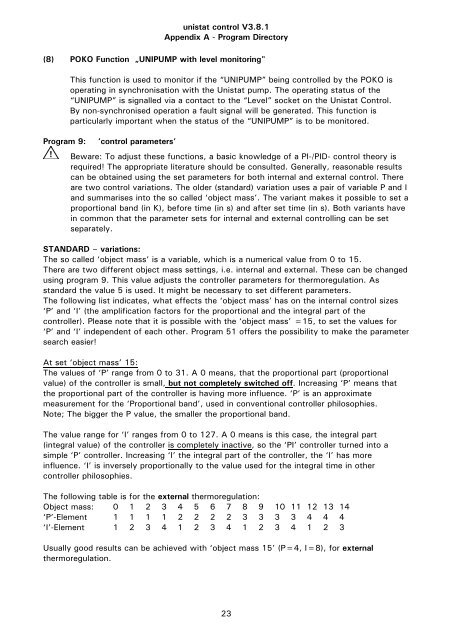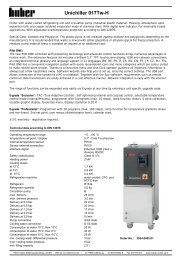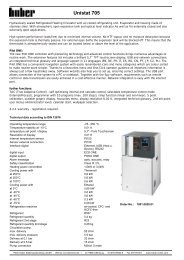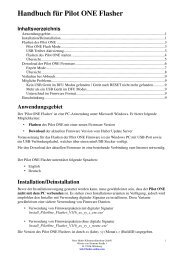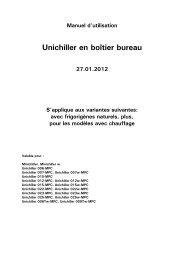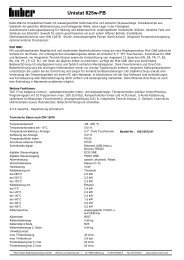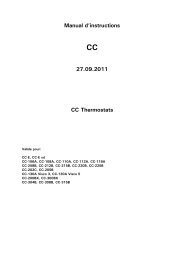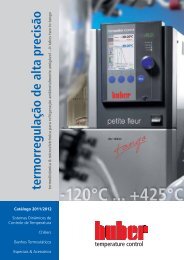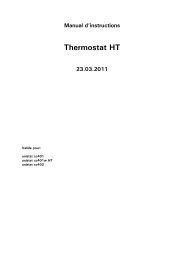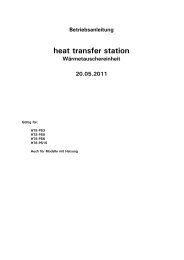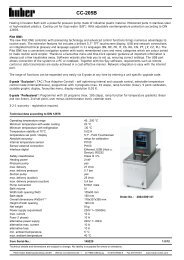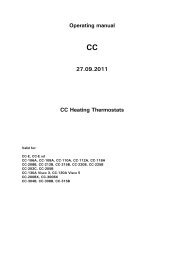Untitled - HUBER
Untitled - HUBER
Untitled - HUBER
You also want an ePaper? Increase the reach of your titles
YUMPU automatically turns print PDFs into web optimized ePapers that Google loves.
unistat control V3.8.1<br />
Appendix A - Program Directory<br />
(8) POKO Function „UNIPUMP with level monitoring"<br />
This function is used to monitor if the “UNIPUMP” being controlled by the POKO is<br />
operating in synchronisation with the Unistat pump. The operating status of the<br />
“UNIPUMP” is signalled via a contact to the “Level” socket on the Unistat Control.<br />
By non-synchronised operation a fault signal will be generated. This function is<br />
particularly important when the status of the “UNIPUMP” is to be monitored.<br />
Program 9: ‘control parameters’<br />
! Beware: To adjust these functions, a basic knowledge of a PI-/PID- control theory is<br />
required! The appropriate literature should be consulted. Generally, reasonable results<br />
can be obtained using the set parameters for both internal and external control. There<br />
are two control variations. The older (standard) variation uses a pair of variable P and I<br />
and summarises into the so called ‘object mass’. The variant makes it possible to set a<br />
proportional band (in K), before time (in s) and after set time (in s). Both variants have<br />
in common that the parameter sets for internal and external controlling can be set<br />
separately.<br />
STANDARD – variations:<br />
The so called ‘object mass’ is a variable, which is a numerical value from 0 to 15.<br />
There are two different object mass settings, i.e. internal and external. These can be changed<br />
using program 9. This value adjusts the controller parameters for thermoregulation. As<br />
standard the value 5 is used. It might be necessary to set different parameters.<br />
The following list indicates, what effects the ‘object mass’ has on the internal control sizes<br />
‘P’ and ‘I’ (the amplification factors for the proportional and the integral part of the<br />
controller). Please note that it is possible with the ‘object mass’ =15, to set the values for<br />
‘P’ and ‘I’ independent of each other. Program 51 offers the possibility to make the parameter<br />
search easier!<br />
At set ‘object mass’ 15:<br />
The values of ‘P’ range from 0 to 31. A 0 means, that the proportional part (proportional<br />
value) of the controller is small, but not completely switched off. Increasing ‘P’ means that<br />
the proportional part of the controller is having more influence. ‘P’ is an approximate<br />
measurement for the ‘Proportional band’, used in conventional controller philosophies.<br />
Note; The bigger the P value, the smaller the proportional band.<br />
The value range for ‘I’ ranges from 0 to 127. A 0 means is this case, the integral part<br />
(integral value) of the controller is completely inactive, so the ‘PI’ controller turned into a<br />
simple ‘P’ controller. Increasing ‘I’ the integral part of the controller, the ‘I’ has more<br />
influence. ‘I’ is inversely proportionally to the value used for the integral time in other<br />
controller philosophies.<br />
The following table is for the external thermoregulation:<br />
Object mass: 0 1 2 3 4 5 6 7 8 9 10 11 12 13 14<br />
‘P’-Element 1 1 1 1 2 2 2 2 3 3 3 3 4 4 4<br />
‘I’-Element 1 2 3 4 1 2 3 4 1 2 3 4 1 2 3<br />
Usually good results can be achieved with ‘object mass 15’ (P=4, I=8), for external<br />
thermoregulation.<br />
23


